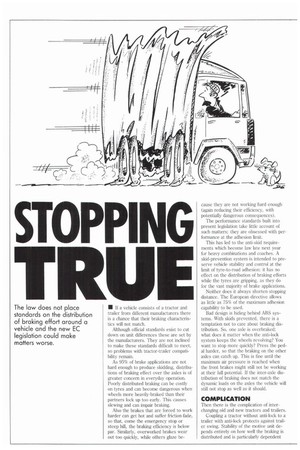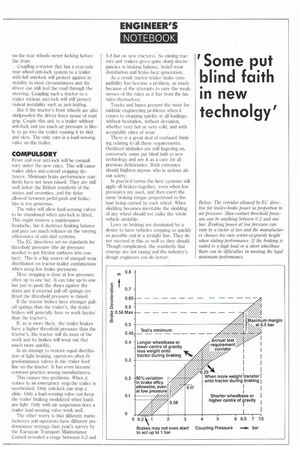STOPPING
Page 40

Page 41

If you've noticed an error in this article please click here to report it so we can fix it.
win
• If a vehicle consists of a tractor and trailer from different manufacturers there is a chance that their braking characteristics will not match.
Although official standards exist to cut down on unit differences these are set by the manufacturers. They are not inclined to make these standards difficult to meet, so problems with tractor-trailer compatibility remain.
As 95% of brake applications are not hard enough to produce skidding, distributions of braking effect over the axles is of greater concern in everyday operation. Poorly distributed braking can be costly on tyres and can become dangerous when wheels more heavily-braked than their partners lock up too early. This causes slewing and can impair braking.
Also the brakes that are forced to work harder can get hot and suffer friction-fade, so that, come the emergency stop or steep hill, the braking efficiency is below par. Similarly, overworked brakes wear out too quickly, while others glaze be
cause they are not working hard enough (again reducing their efficiency, with potentially dangerous consequences).
The performance standards built into present legislation take little account of such matters; they are obsessed with performance at the adhesion limit.
This has led to the anti-skid requirements which become law late next year for heavy combinations and coaches. A skid-prevention system is intended to preserve vehicle stability and control at the limit of tyre-to-road adhesion: it has no effect on the distribution of braking efforts while the tyres are gripping, as they do for the vast majority of brake applications.
Neither does it always shorten stopping distance. The European directive allows as little as 75% of the maximum adhesion capability to be used.
Bad design is hiding behind ABS systems. With skids prevented, there is a temptation not to care about braking distribution. So, one axle is overbraked; what does it matter when the anti-lock system keeps the wheels revolving? You want to stop more quickly? Press the pedal harder, so that the braking on the other axles can catch up. This is fine until the maximum air pressure is reached when the front brakes might still not be working at their full potential. If the inter-axle distribution of braking does not match the dynamic loads on the aides the vehicle will still not stop as well as it should.
COMPLICATION
Then there is the complication of interchanging old and new tractors and trailers.
Coupling a tractor without anti-lock to a trailer with anti-lock protects against trailer swing. Stability of the motive unit depends entirely on how well the braking is distributed and is particularly dependent on the rear wheels never locking before the front.
Coupling a tractor that has a rear-axle rear-wheel anti-lock system to a trailer with full anti-lock will protect against instability in most circumstances and the driver can still feel the road through the steering. Coupling such a tractor to a trailer without anti-lock will still protect violent instability such as jack-knifing.
But if the tractor's front wheels are also skidproofed the driver loses sense of road grip. Couple this unit to a trailer without anti-lock and too much air pressure is likely to go into the trailer causing it to skid and slew. The only cure is a load-sensing valve on the trailer.
COMPULSORY
Front and rear anti-lock will be compulsory under the new rules. This will cause trailer slides and extend stopping distances. Minimum brake performance standards have not. been raised. They are still well below the British standards of the sixties and seventies, and the delay allowed between pedal-push and brakebite is too generous.
The rules will allow load-sensing valves to be abandoned when anti-lock is fitted. This might remove a maintenance headache, but it destroys braking balance and puts too much reliance on the varying efficiencies of anti-skid systems.
The EC directives set no standards for threshold pressure (the air pressure needed to put friction surfaces into contact). This is a big source of unequal wear distribution on tractor-trailer combinations when using low brake pressures.
Most stopping is done at low pressure: often up to one bar. It can take up to one bar just to push the shoes against the drum and if external pull-off springs are fitted the threshold pressure is raised.
If the tractor brakes have stronger pulloff springs than the trailer's, the trailer brakes will generally have to work harder than the tractor's.
If, as is more likely, the trailer brakes have a higher threshold pressure than the tractor's, the tractor will do most of the work and its brakes will wear out that much more quickly.
In an attempt to restore equal distribution of light braking, operators often fit predominance valves in the trailer feed line on the tractor. It has even become common practice among manufacturers.
This causes two problems. When it comes to an emergency stop the trailer is overbraked. Only anti-lock can stop a slide. Only a load-sensing valve can keep the trailer braking modulated when loads are light. Only with air suspension does a trailer load-sensing valve work well.
The other worry is that different manufacturers and operators have different predominance settings (last year's survey by the European Transport Maintenance Council revealed a range between 0.2 and
1.8 bar on new tractors). So mixing tractors and trailers gives quite sharp discrepancies in braking balance, brak&wear distribution and brake-heat generation.
As a result tractor-trailer brake compatibility has become a problem, as much because of the attempts to cure the weaknesses of the rules as it has from the lax rules themselves.
Trucks and buses present the most formidable engineering problems when it comes to stopping quickly at all loadings, without hesitation, without deviation, whether very hot or very cold, and with acceptable rates of wear.
There is a great deal of confused thinking relating to all these requirements. Outdated attitudes are still lingering on, conversely some put blind faith in new technology and see it as a cure for all previous deficiencies. Both extremes should frighten anyone who is serious about safety.
In practical terms the best systems will apply all brakes together, even when low pressures are used, and then exert the same braking torque proportional to the load being carried by each wheel. When skidding becomes inevitable the skidding of any wheel should not make the whole vehicle unstable.
Laws on braking are dominated by a desire to have vehicles stopping as quickly as possible and in a straight line. They do not succeed in this as well as they should. Though complicated, the standards that emerge are not taxing and the industry's design engineers can do better.
Below: The corridor allowed by EC directive for trailer-brake power in proportion to air Pressure. Shoe-contact threshold pressure can be anything between 0.2 and one bar. Braking power at low Pressure can vary by a factor of Iwo and the manufacturer chooses his own centre-of-gravity height when stating performance. If the braking is suited to a high load or a short wheelbase there can be difficulties in meeting the legal minimum performance.












































































































